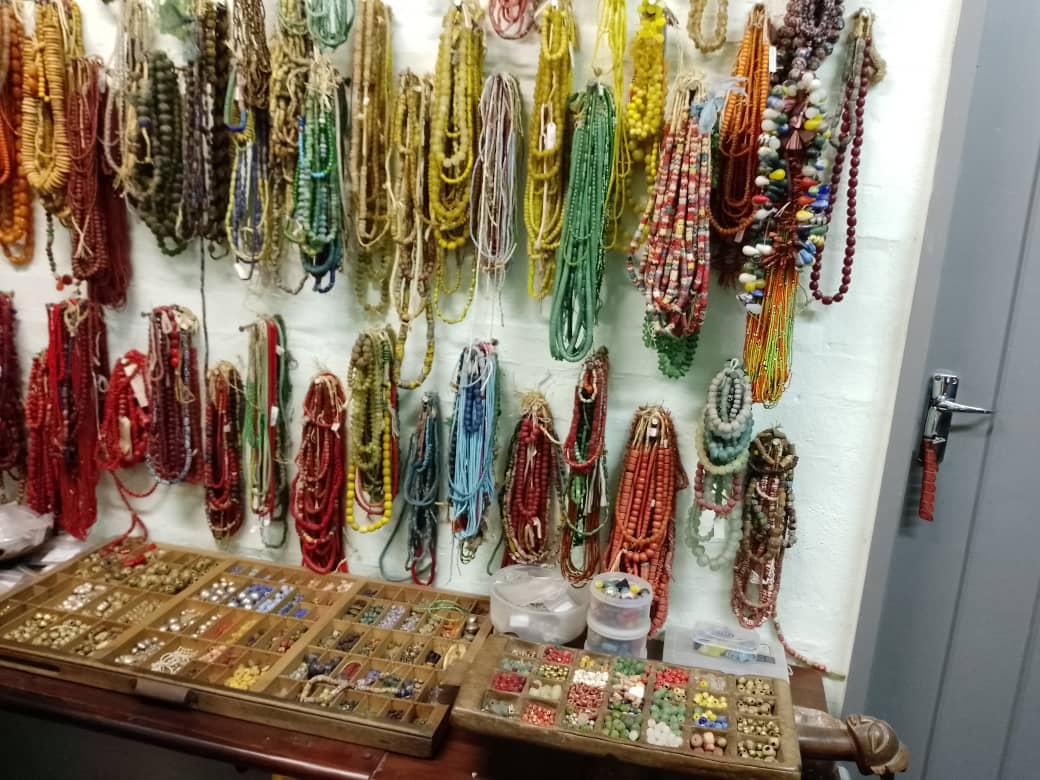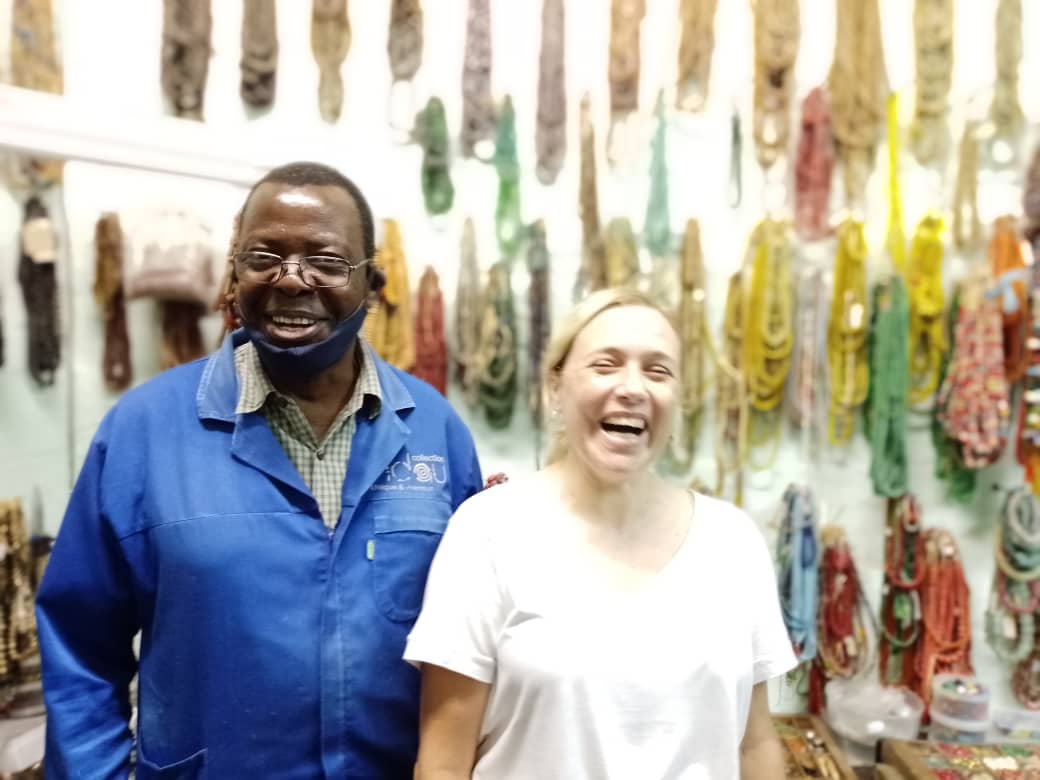|
Getting your Trinity Audio player ready…
|
One organisation that has shown resilience and tenacity in the midst of COVID-19 is the Ndau Collection in Victoria Falls, a true repository of fashion, arts, and culture.
It is a part of small-to-medium enterprises that have remained vigilant and raring to go despite the COVID-19 pandemic that threatened to decimate tourism and other services industries in the resort town of Victoria Falls.
“Victoria Falls had the first case of COVID-19 in Zimbabwe. Being the country’s prime tourist destination, the town was immediately put under lockdown and the measures had a hard knock on people’s livelihoods with many losing their jobs in the aftermath of the COVID-19 restrictive measure spearheaded by the Ministry of health.
“A majority of the residents out of a population of about 35 000 people was thrown into abject poverty. The government and other stakeholders including donors and development partners chipped in with food assistance and some basic living allowances. I would like to comment on the multi-stakeholder partnerships in this town that literally made us almost win the fight against COVID-19. People came together and pooled financial resources to buy food for the needy.
“We even joined hands to preach about the need for observing all COVID-19 regulations. Over and above that, the community, through donors and partners like Love for Africa that is owned by Blessing Munyenyiwa, sourced donations and managed to procure two oxygen concentrators from the United States and Germany that are at the Victoria Falls Hospital. As we speak, there is also a well-equipped and functional intensive care unit at the hospital. As a community, we have also employed specialist medical doctors and dentists, and put up a COVID-19 free testing and treatment centre. Today, we are proud to say that despite being the first town to record the first medical COVID-19 case in the country, Victoria Falls has achieved herd immunity and tourism is on a path towards recovery, thanks to the invaluable contribution of SMEs in the tourism sector,” said Christie Brookstein, the Ndau Collection’s Creative Director.
There are private doctors who volunteered to work on the COVID-19 side. The government medical team headed by District Medical Officer, Dr Fungai Mvura run the COVID-19 centre on a day to day basis, working many hours overtime freely.
The Ndau Collection is a collective of designers in Victoria Falls, Zimbabwe, brought together by a love of African culture, history, and design. They specialise in the creation of unique jewelry, accessories, and one-of-a-kind collectibles, all made by highly skilled artisans.

The Ndau Collection was formed in 1998 by current owners Gail van Jaarsveldt and Gill Atherstone, as a result of their passion for African beadwork. Gill subsequently moved back to Harare and Gail was joined by her daughter Christie Halsted as co-owner of the company. Together they have grown the Ndau Collection and pieces from the collection have found their way to all corners of the globe and gained international recognition.
Each of Ndau Collection sterling silver beads and fittings is made using the centuries-old African lost wax casting technique and is handmade from beginning to end. This results in a beautifully soft, curvaceous finish to its metal work that gives it the feel of the history it represents.
“We combine these cast pieces with our extensive collection of antique African trade beads, precious and semi-precious stones, natural materials, exotic leathers, and treasures we find in our travels, to create our one-of-a-kind jewelry, accessories, and collectibles.
“Every piece takes several weeks to create and is hand-worked throughout. Each of our pieces is either unique, a bespoke creation, or part of a limited edition run of specially selected castings. We believe strongly in promoting local talent and work with local carvers, wire workers, mosaics, and fine pencil artists. These artists are supported, mentored, and promoted through The Ndau Collection under The Ruoko Project,” Halsted said.
AWARDS
Emerging Accessories Designers 2013 – MAGIC, Las Vegas
Accessories Designers of the Year 2013 – Zimbabwe Fashion Week
Accessories Designers of the Year 2014 – Zimbabwe Fashion Week
Finalists for Accessories Designers of the Year 2014 – Africa Fashion Awards
GAIL VAN JAARSVELDT
Gail van Jaarsveldt is the founder of the company and co-owner with her daughter Christie Halsted. Whilst never formally trained, Gail has an innate sense of design and an uncanny eye for what works – she describes herself as an ‘ideas person’. She is Zimbabwean born and has worked in Victoria Falls most of her life, where she has played a major role in the town’s development. A passionate supporter of local design and culture Gail has amassed a museum’s worth of local art and craft.
She combines her extensive knowledge of the leather and retail industry with Ndau’s products to create amazing pieces. Gail says she is happiest in her new role as grandmother to Blayke, Maya, Emil, and Quinn! Her latest collection, African Renaissance, created from rare African Trade beads, gold-dusted vermeil and African brass beads is a sell-out success.
JOE MUTOKO
Joe Mutoko is The Ndau Collection’s head silversmith and stone-cutter and has been with The Ndau Collection since it began. As a descendent of the Ndau tribe, renowned for their high artistic skills and rich culture, he suggested the name ‘Ndau’ as he felt this to be the perfect name for the company’s unique creations.
Joe is a third-generation traditional jeweller, with both his grandfather and his uncle having created traditional Shona beads. He has followed in their footsteps and loves to work with the beautiful precious and semi-precious stones found locally when creating, along with his other favourite material buffalo horn.
He is passionate about conserving local wildlife and spends most weekends in the bushveldt with a fishing rod. His technical and design knowledge is an invaluable asset and he heads up the production team that brings the Ndau designs to life. Joe has been solo designing since 2011 and brings a clean, elegant style to every piece he creates. His distinctive style has helped to shape the Ndau Collection’s brand.
We are very proud to have recently welcomed Joe’s son into our Ndau family as a trainee.
CHRISTIE HALSTED (SABAG)
Christie is Gail’s eldest daughter and co-owner of The Ndau Collection. She has a passion for design and an obsession with perfection that has led to her excelling in her career. She began learning ceramic sculpture from her aunt, Fee Halsted (Ardmore Ceramics) she then studied at Ruth Prowse Art College in Cape Town, where she realised formal art education wasn’t for her. She moved into the world of eventing, where she worked with a large number of international corporations.
Christie has emerged as a talented jewelry designer who pushes the limits of design and constantly moves Ndau into new fields. She first introduced the combination of croc skin with sterling silver that has become so synonymous with Ndau’s brand. She is currently on sabbatical, creating a spectacular lodge on her and her husband’s private island.
MATERIALS & METHODS
Our pieces are hand-created in sterling silver, with precious and semi-precious stones, rare antique African trade beads and exotic leathers and found materials.
AFRICAN TRADE BEADS
African trade beads have a varied history. The first glass beads were made in Murano, Venice, and brought to the African continent by traders for ivory, gold and commodities. The African people had always created their own beads from natural materials and clay, and as far back as the 11th century created ‘lost wax’ cast beads. As trade increased with Africa, the demand for beads grew and Holland and Bohemia began to make glass beads. High value was placed upon beads as a form of ethnographic money, exchanged for gold, ivory, and other goods by traders from Europe and Asia. To the local people, the Portuguese traders were known as the “Europeans who scattered beads among the people in front of palaces.” Bead-making then eventually passed to production in India and as the African people came to understand the process, they began to make their own beads.
EXOTIC LEATHERS
Our crocodile and ostrich skins are all sourced locally in Zimbabwe. We are lucky enough to have access to top international quality skins through Kevin van Jaarsveldt, Gail’s husband. He is considered to be the top crocodile skin grader in the world and product that passes through his selection end up at Louis Vuitton and other top international design houses. We are privileged to purchase our skins directly through him. All of the crocodile skins produced in Zimbabwe are farmed on crocodile farms and it is a direct result of farming that crocodiles are no longer on the verge of extinction in the wild.
In the 1950s, 60s and 70s, wild crocodiles were hunted to such an extent that they disappeared from some areas of the world. The introduction of CITES regulations and farming, whereby a percentage of juveniles were released back into the wild, once they were a size that ensured survival, led to the resurgence of wild populations. Zimbabwe was one of the forerunners in this endeavour, with programs based on the sustainable use of crocodilians to generate conservation benefits.
The main by-product of crocodile farming is meat, with China and Hong Kong the main importers. Virtually all other crocodile parts are utilised, including blood (pharmaceuticals), bones, fat (traditional medicines), teeth, heads, skulls (tourist curios), etc. We even use sections of skin previously not used in bag and accessory manufacture, such as the Hornback and end tail section. The C.I.T.E.S. Convention regulations (enacted in 1975) control the trade and import/ export of all listed animal products. For example, all crocodilian skins in international trade must have a uniquely numbered, non-reusable tag attached to them – this allows “legal” skins to be readily identified. As both our crocodile and ostrich skins come from farmed sources, all articles made from these materials are legally able to be exported, with Nile crocodiles (crocodylus niloticus) considered Appendix II. We do advise that you check with your relevant local authority prior to purchasing any of our exotic material pieces.
For more information, please visit the IUCN website.
METHODS
Lost Wax Casting Method
This is a centuries-old technique, dating as far back as the 11th century in the kingdom of Benin. First, either an original piece is carved in wax or liquid wax is injected into a mould to create an exact copy of the original. After careful cleaning and checking, these are attached to a central bar known as a tree. This is then inserted into a cylinder flask and liquid investment (similar to plaster-of-Paris) poured in. The investment is set to bake hard in an oven for ten to twelve hours and during this time, the wax melts and evaporates out – giving rise to the name ‘lost wax’. The metal intended for casting is then smelted at high heat until it is molten and poured down the channel left by the evaporated tree and from there into the individual pieces. Once the metal has set, the investment is washed away with water and the cast revealed, ready for the polishing process to begin. Each piece is cut from the tree and cleaned and polished up to six times in varying processes, culminating in a final polish by hand to reveal the gleaming metal.
